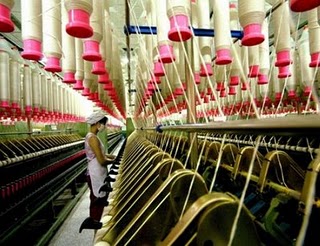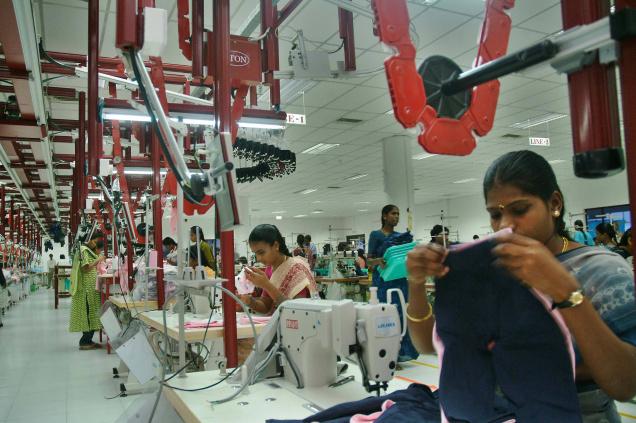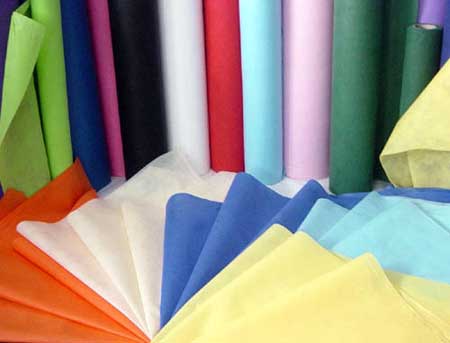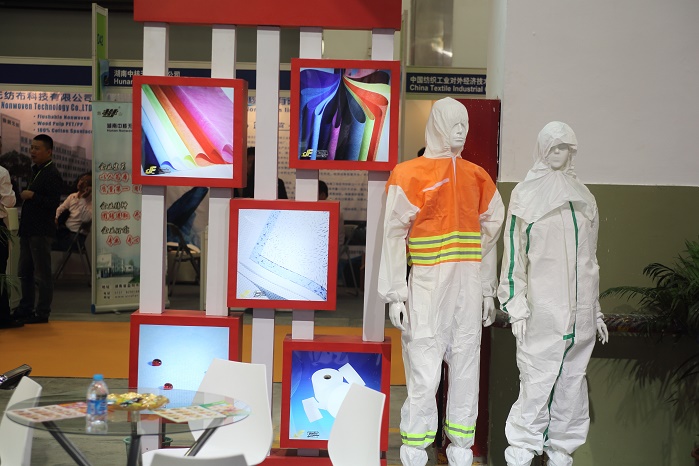FW
"The new scheme specifically targets employment generation and exports in apparel and garment industry. It will provide employment to women in particular and increase India’s share in global exports; promote technical textiles for export and employment; promote conversion of existing looms to better technology looms for improvement in quality and productivity; encourage better quality in processing industry and checking need for import of fabrics by the garment sector."

Benefits from new ATUFS
The new scheme specifically targets employment generation and exports in apparel and garment industry. It will provide employment to women in particular and increase India’s share in global exports; promote technical textiles for export and employment; promote conversion of existing looms to better technology looms for improvement in quality and productivity; encourage better quality in processing industry and checking need for import of fabrics by the garment sector.

Rahul Mehta, President, CMAI feels, the new scheme is a relief to the entire textile sector, especially because the RR-TUFS was in a limbo and no unique ID, which is the formal sanction under the scheme, has been issued after September 2014. “Allocating nearly Rs 13,000 crores (1985 million USD )for clearing the committed liabilities will help in clearing the backlog pending for issuance of UIDs and also the large number of so called 'left out cases' that have been pending for a decision for nearly four years,” he said.
AEPC Chairman, Virender Uppal believes ATUFS will provide the much needed thrust for the expansion and growth of the apparel industry along with the employment generation in India. Reiterating similar views, Shishir Jaipuria, Chairman, FICCI Textiles and Technical Textiles Committee says, “The approval has come as a great relief to the industry especially when the exports were declining in textile and apparel sector. The focus on employment generation and export under the new TUFS by encouraging apparel and garment industry and promotion of technical textile sector, is indeed a welcome step which will help in furthering the cause of Make in India."
Under the ATUFS, all cases pending with the Office of Textile Commissioner which are complete in all respects shall be provided assistance under the ongoing scheme and the new scheme will be given prospective effect.
‘Make in India’ gets renewed attention
The amended scheme is expected to boost ‘Make in India’ initiative in the textiles sector and attract investment to the tune of one lakh crore rupees, and create over 30 lakh jobs. A budget provision of Rs 17,822 crores (2721million USD) has been approved, of which Rs 12,671 crores (1935million USD) is for committed liabilities under the ongoing scheme, and Rs 5,151 crores (787 million USD) for new cases under ATUFS.
Office of Textile Commissioner (TXC) is being reorganised; its offices shall be set up in each state. Officers of the TXC shall be closely associated with entrepreneurs for setting up the industry, including processing proposals under the new scheme, verifying assets created jointly with the bankers and maintaining close liaison with the State Government agencies.
M Senthilkumar, Chairman, The Southern India Mills’ Association (SIMA) welcoming the timely move by the government, said that the ATUFS would enable the textile industry to ease their financial position and also plan investments. He appreciated the announcement of ease of doing business and also reorganisation of the Office of the Textile Commissioner so that the TxC could closely associate with the entrepreneurs, bankers and state governments and implement the projects on a fast track mode.
The implementation of the scheme would be executed and monitored online under iTUFS, launched in April, 2015. Under the new scheme, there will be two broad categories: apparel, garment and technical textiles, where 15 per cent subsidy would be provided on capital investment, subject to a ceiling of 30 crores rupees (4.581million USD)for entrepreneurs over a period of five years, and remaining sub-sectors would be eligible for subsidy at a rate of 10 per cent, subject to a ceiling of Rs 20 crores (3.054 millionUSD).
Thanking the government for the extra focus provided to the highly labour intensive apparel segment and the highly potential technical textiles by stipulating a higher capital assistance of 15 per cent against 10 per cent available to other segments, Mehta said that the apparel industry was not very capital intensive, but given the sub-scale operation of production facilities in this segment in the country and the need to achieve economies of scale for competing with large units in countries like China, Bangladesh and Vietnam, the higher assistance to the apparel segment will prove to be highly beneficial in pushing both employment and exports in our textiles sector.
Texmin.nic.in
The textile sector reviewed a number of initiatives implemented through 2015 to boost the health of the entire sector. At its year-end review, the Textiles Ministry listed the initiatives it undertook in 2015.
The handicrafts sector benefited a lot under the Government's revised handicrafts schemes and strategy, which included infrastructure development, such as a Common Facility Centre in every cluster, development of design and training, through schemes under Office of DC (Handicrafts), direct assistance to artisans, such as online assistance through their bank accounts and linking up with market (including e-commerce) with participation of private sector.
The handlooms sector also received a major thrust with the Government launching 'India Handloom' brand for promoting high value handloom products with new design, zero defect in fabrics, zero effect on environment and assurance to consumer to about genuineness and quality of the product. As far as the power loom sector is concerned, the Textiles Ministry launched a pilot scheme to upgrade existing plain powerlooms to semi-automatic looms by providing additional attachments and to enable the power loom weavers to improve the production and quality of fabrics to face the competition in domestic and international markets.
In the silk sector, production targets for the year 2014-15 were achieved, the review said. The amount of Rs 297.58 crores allocated for the year 2014-15 for plan developmental activities has been fully utilised. For the year 2015-16, an allocation of Rs178.10 crores has been approved, against which, an amount of Rs 145.74 crores has been released as on November 3, 2015.
According to the review, to safeguard interests of domestic cotton growers, a well-planned, largest ever Minimum Support Price operation was carried out by the Cotton Corporation of India in the 2014-2015 cotton season, in all 11 cotton producing states. This operation was highly successful, with procurement crossing 86 lakh bales up to March 30, 2015.
In the wool sector, the Central Wool Development Board, Jodhpur (CWDB) has implemented different schemes for development of the sector with various schemes such as Pashmina promotion programme, Sheep & Wool Improvement Scheme and Angora Wool Development scheme in Himachal Pradesh and Manipur. To safeguard interests of producers and manufacturers of jute and jute products estimated at about 4.35 million families, the Government in January 2015, approved orders for mandatory packaging of food grains in jute bags and subsidy to Jute Corporation of India to support MSP operations in jute. The validity of the order was later extended up to December 31, 2015.
Texmin.nic.in
Stretchline Holdings is the world’s largest branded narrow fabric manufacturer. Since 1996 it has a state-of-the-art plant with a world class dye house. Now, Stretchline is using robotic technology to develop more innovative products through application of silicone material, for compression or grip, to textiles for fashion, medical, sportswear and garments.
The robot allows the company to accurately program rotation speeds and positions for applying silicone on a garment. Stretchline has firmly established itself as the world’s leading brand of narrow performance fabric for intimate and active apparel. The company has manufacturing plants in Sri Lanka, China, Indonesia, Mexico, Honduras, US and UK which are supported by marketing offices in the US, UK and Hong Kong, enabling the group to provide needle point support to the world’s leading lingerie and active wear brands.
Stretchline is a three way joint venture between Stretchline (UK), MAS Holdings (Sri Lanka) and Brandot International Ltd (USA) that was first established in 1996. Stretchline UK is a product of the merger of two elastic giants Charnwood Elastic Group (UK) and Tubbs Elastic Group (UK) that can boast of over 150 years’ experience in the industry.
Shima Seiki one of the leaders in knitting technologies sees Asia as one of its biggest and fast growing markets. Bangladesh is currently the fastest moving market for the company as the industry is rapidly converting its hand flats into automated flats. Another upcoming market is Vietnam, and the company is upbeat about the country more so after the recent TPP agreement which makes Vietnam a manufacturing base for exports into the US and Canada. Many Hong Kong and Chinese companies are looking at the option of setting up units in Vietnam, and a whole new market has opened up for Shima Seiki.
In India, brand owners and spinning mills alike are target customers for the company. Mills are moving up the value chain and flat knitting is a direct link between the yarn and the final product. Shima Seiki already has a good presence in the country especially among manufacturers focused on the export market.
Shima Seiki’s whole garment technology was pioneered 20 years ago. While Europe and Japan are using this technology extensively, its potential is yet to be explored in Asia. Flat knitting is no longer associated with woolen sweaters. Many different yarns can be used to make varied product categories using the technologies available with Shima Seiki.
www.shimaseiki.com/
Gujarat has been India’s leading cotton producing state owing to its abundant black soil. It sells nearly 120 lakh bales a year, two-thirds of this to Tamil Nadu. Hosiery yarn makers spin the sought-after Sankar 6 variety from Gujarat to make garments sold across the world, including top retailers such as Walmart and Macy’s in the US.
Sankar 6 is priced at Rs 34,000 to Rs 34,200 a candy. Gujarat cotton commands a premium over competing states because it requires fewer chemicals for dyeing, among other advantages. However, pink worm infestation in cotton crops and lack of water for irrigation have spoiled the quality of a huge quantity of cotton bales. This has made yarn manufacturers in Tamil Nadu look to overseas markets.
About 43 mills in the textile hub of Coimbatore and Tirupur are turning to West African nations to replace the supply from their decades-old source as they seek more meters of yarn per bale of cotton. They plan to procure cotton from countries like Mali, Ivory Coast and Burkina Faso.
One advantage is that imports can be booked in January, all the way up to June at a steady price from West African countries. This will provide a continuous supply of the same fiber at lower interest rates of around 2.5 per cent a year.
The United States will allow duty-free access to Nepalese readymade garments until 2025. In addition, the US will provide economic as well as technical assistance to Nepal’s garment sector, which would in turn improve the competitiveness of its garments in the global market. Until now, the US had been imposing a 16 to 17 per cent duty on Nepalese garments.
The preferential market access provides Nepal an opportunity to increase its garment exports. The new duty-free access to the US apparel and textile market is expected to revive the dying garment companies of Nepal. The Nepalese garment industry was a flourishing industry but it saw a drastic decline since the quota system ended in 2005. Garment exports dropped from an all time high of Rs 13 billion in 2000-1 to Rs 5.28 billion in 2014-15. Most readymade garment factories closed down leaving only about 50 in business today. There were 400 in 2001.
The major drawback of Nepal’s garment industry is its cost of transportation that increases the price of the product and makes it difficult to compete with other countries such as Bangladesh that produce garments at cheaper prices. Taxes on imported raw materials are very high. There is a problem of erratic power supply.
TRENDSPOTTING 2016 - "With the world on one page on the need for environment consciousness and ecofriendly way of living, the fashion and apparel industry is expected to witness ‘sustainability’ as a major trend in 2016. With a global market size of $3 trillion, the industry’s environmental responsibility is massive."

Growing concern over fashion’s carbon footprint

The fashion, apparel and textiles industry accounts for 10 per cent of global carbon emissions, being the second largest industrial polluter, after oil. According to Eileen Fisher, a clothing industry giant, fashion is a complicated business which involves a long and varied supply chain, raw material, textile manufacture, clothing construction, shipping, retail, use and ultimate disposal of the garment. She opines fashion’s carbon footprint is huge and a assessing how much it is, by itself is an overwhelming task. A general assessment needs to take into account the obvious pollutants like pesticides used in cotton farming, toxic dyes used in manufacturing and great amount of waste discarded clothing creates while also looking at the extravagant amount of natural resources used in extraction, farming, harvesting, processing, manufacturing and shipping. Moreover, organisations like the ‘Greenpeace Detox’ campaign, has challenged some of the world’s most popular clothing brands to eliminate all releases of hazardous chemicals.
The major type of pollutant generated by the industry is production waste. It’s estimated that 15 per cent of textiles intended for clothing ends up on the cutting room floor. Second, is consumer waste. There has been a 60 per cent increase in fashion consumption in the last 10 years, with 150 billion new garments thought to be produced ever year. The rise in fast fashion has prompted designers, manufacturers and retailers to go overdrive to satisfy this consumer appetite. Consumers are also throwing a huge amount of clothes away. In Hong Kong, around 12,000 garments enter landfills every hour.
Fashion globalisation has also resulted in garment trading across the globe in a container ship running on the dirtiest of fossil fuels. Besides, the current trend in fashion retail creates a great demand for quick and cheap clothes, which is another big issue. Textile dyes too are harmful as they create a chemical Fukushima in Indonesia and the Citarum River is considered one of the most polluted rivers in the world, partly because of the textile factories lined up on its shores. With 68 per cent of the industrial facilities on the Upper Citarum producing textiles, the adverse health effects on five million people living in the river basin and wildlife are alarming, as per Greenpeace.
COP 21’s impact and global initiatives in 2016
Growing concerns over alarming level of pollution generated by fashion and textile industry has prompted developing nations to ink a deal to reduce environmental risks. December 2015 witnessed a landmark agreement between representatives of 195 countries to cut emissions of greenhouse gases, the COP21 deal, which comes into effect in 2020. It aims to ensure that global warming does not exceed 2 degrees C above pre-industrial levels, with an additional aim to cap this at 1.5 degrees C. A temperature rise of 2 degrees C could result in catastrophic environmental changes, such as extreme weather, accelerated melting of the polar ice caps and dangerous rises in sea levels.
Global fashion players like Nike, H&M, Levis Strauss, Adidas, Hugo Boss have welcomed this revolutionary agreement as a major step in reducing carbon footprint. In 2016, the initiatives taken by these major players will play a significant role in changing the trend across the globe. According to Hannah Jones, Chief Sustainability Officer at Nike, this agreement marks a transformative moment on the journey towards a low-carbon economy, providing the certainty and confidence businesses need to continue to pursue positive climate action. Reiterating his views, Pierre Börjesson, Sustainability Business Expert on climate at H&M too is of the opinion that the deal is a step towards a safe environment with continued growth and increased quality of life for more people around the world.
The deal has set an additional aim to cut global warming to 1.5 degrees centigrade and companies like Kering are coming forward support the cause. In 2012, Levi Strauss announced its commitment to cut its greenhouse gas emissions by 25 per cent by 2020. By 2014, the company achieved its mission by 20 per cent. The company will continue to update its climate strategy and targets in 2016. The part of Paris agreement is countries’ committed to raise $100 billion a year by 2020, to help developing nations mitigate and adapt to the consequences of climate change.
Balancing environmental responsibility and business growth
The carbon footprint generated by the production of raw materials like cotton and cashmere is massive as they consume huge amounts of electricity and water. The materials sourced from those regions of the developing nations that can face the early adverse impacts of any environmental change, such as flooding and droughts. Even production of rayon and viscose can lead to deforestation and companies must take note of these climatic changes to save the planet. Experts suggest the players to make use of alternative eco-friendly fuels while transporting goods to reduce pollution. Simultaneously, there is also a need for the end consumer to accept the individual responsibility towards environment to reduce carbon footprint that can be achieved only when there is an increased awareness about it and the consumer is encouraged to care for eco friendly products.
However the concern for fashion brands in 2016 will be to balance sustainability and continuity of business growth as investing in renewable resources can be high. While global corporations like Google, H&M, Nike, and Yoox Group are already a part of this initiative. But it is to see if the initiative is also taken up with such promptness by fashion players across the globe. Though there are incentives from governments to follow a low carbon path however, concerns continue to loom large around the real costs that these investments will mean for businesses and finally if governments can make private sector accountable for its impact on the planet.
"According to a survey conducted by China Nonwovens and Industrial Textile Association (CNITA), the production index of the industry in the first three quarters is 61.2, still within the growing range, but it is lower than the 67.3 in the first-half year, staying at bottom level in recent years. The low production index, experts say, is because of slower growth of domestic demand resulting from the downward pressure of domestic macro-economy and the weaker demand of major economies in the world."

Data from the National Bureau of Statistics (NBS) show that in the first three quarters of this year, nonwoven fabric producers above designated size (with annual turnover more than CNY 20 million) produced near 3.21 million tons of nonwoven fabric, up 15.57 per cent over the same period of last year, accelerating about 6 percentage points compared to the first-half year and over 10 percentage points compared to same period of last year.
Shandong Province leads growth

China’s all major nonwoven fabric producing provinces / autonomous regions maintained steady growth, and especially, the nonwoven fabric production in Shandong Province increased nearly 30 per cent, consolidating its position as the number one nonwoven fabric producer in China.
According to a survey conducted by China Nonwovens and Industrial Textile Association (CNITA), the production index of the industry in the first three quarters is 61.2, still within the growing range, but it is lower than the 67.3 in the first-half year, staying at bottom level in recent years. The low production index, experts say, is because of slower growth of domestic demand resulting from the downward pressure of domestic macro-economy and the weaker demand of major economies in the world.
According to the NBS, China's technical textile sector invested CNY 49.12 billion in fixed assets in the first nine months, up 23.26 per cent year-on-year and the number of newly-launched project increased 18.34 per cent, both improved compared with the figures for the first-half year, but declined compared with same period of last year. The investment in nonwoven fabric sector accelerated from 7.17 per cent in the first half to 15.54 per cent, while the decline in the number of newly-launched projects narrowed from 9.5 per cent to 0.4 per cent.
In January-September, the economic performance of technical textile industry continued to improve. Figures from the NBS show that enterprises above designated size earned CNY 212.7 billion of prime business revenue and CNY 12.3 billion of profits, up 6.76 per cent and 15.98 per cent year-on-year respectively, both accelerating over 1 percentage point compared to the first-half year and the profit rate of the industry is up to 5.78 per cent. The prime business revenue continued to grow at lower than 10 per cent.
This, the data indicates, is a reflection of not only the slow demand, but also the declined selling prices of finished products on the back of dropping raw material prices. But the profitability of the industry improved, offering opportunity for the industry's restructuring.
Exports to the US up as economy improves
In the first three quarters, China's exports of technical textiles dropped slightly by 0.91 per cent from a year earlier to $15.28 billion. Among major exported products, only the exports of medical and hygienic textiles as well as awnings increased in value term, while the exports of other products dropped by various degrees. For example, the exports of plastic-coated fabric and nonwoven fabric dropped by 3.3 per cent and 3.2 per cent respectively. Quantity growth remains the main engine for pushing up the export value.
Market-wise, owing to its economic recovery, the US market played an important role in maintaining the steady growth of China's technical textile exports. In January-September, China's export to the US market grew 6.9 per cent year-on-year. Meanwhile, the exports to Vietnam and the ROK edged up 1.9 per cent and 3.7 per cent respectively. China's technical textile export to Japan, the second largest market, dropped by 3.8 per cent, and the exports to India and Germany declined 11.2 per cent and 9.3per cent respectively.
In the first three quarters, China's import of technical textiles grew 5.34 per cent year-on-year to $3.39 billion. The rising import is mainly contributed by the 87.8-per cent rise in the import of diapers. Without the diaper import, the total import would drop 9.3 per cent from a year earlier.
Overall, the statistics suggest that China's technical textile sector has maintained the healthy and steady developing trend.
www.stats.gov.cn
Brazilian denim mill Vicunha which works directly with high profile jeans brands to create specialised yarns and finishes has come up with its collection for Spring/Summer ’17 which is super smart products includes a range of hyper stretch denims and twills ensuring high performance and great flexibility with fabrics providing close to 100 per cent elasticity. The bistretch line allows body sculpting fits offering total movement designed to guarantee maximum freedom, flexibility and resistance.
The mill is also introducing dual core garments containing elastan and T400 for quality, comfort and a luxurious hand feel. Vicunha has invested deeply in dual-core spinning technology, becoming the largest dual core spinner in North and South America.
Vicunha is the world’s leading carrier of BCI cotton. It uses 1,00,000 tons of BCI cotton per year, which is almost five per cent of the global supply. The mill focuses heavily on super stretch, durability and products containing BCI cotton. Vicunha continues to participate in protecting the environment by using an unique recycling strategy.
In terms of yearly sales, Vicunha is the largest Brazilian enterprise in the textile and clothing sector. Vertically integrated, Vicunha is engaged in spinning, weaving, and knitting textile fibers, dyeing and printing fabrics, and making garments. Its products consist of filaments, yarns, denim fabrics and twills, knitted fabrics, synthetic woven fabrics, and readymade articles of clothing.
www.vicunha.com.br/
Nahar Spinning Mills, part of Ludhiana based Nahar Group of Companies, has received its board’s approval at its meeting held on December 23, 2015 for developing a new spinning plant with 60,480 spindles at Village Tamot, in the State of Madhya Pradesh. Nahar is one of the largest integrated textile player and also the second largest cotton yarn manufacturer in India.
Nahar Spinning Mills started out as a small worsted spinning and hosiery unit in Ludhiana and witnessing steady growth in woollen/cotton hosiery knitwear and woollen textile exports, the company has today emerged as one of the recognised ‘Export and Trading House’ by the Government of India.
The company today has an ultra-modern facility to manufacture 12.5 million pieces of hosiery garments and its products such as T-shirts are exported to reputed international brands like GAP, Arrow, Old Navy, Banana Republic and Chaps, among others.
It has plants spread over seven multi location plants, producing a range of products, over 60 per cent of which is aimed at export markets – USA, UK, France, Brazil, Bangladesh, Mauritius, Hondurus, Argentina, Colombia, Peru, Chile, Netherlands, Japan, Canada, Korea, Taiwan, Hongkong, Singapore, Egypt and Russia.
www.ovmnahar.com












